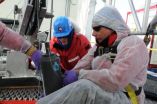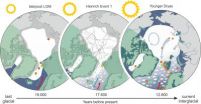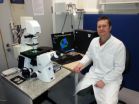(Press-News.org) CAMBRIDGE, MA -- In the near future, the package that you ordered online may be deposited at your doorstep by a drone: Last December, online retailer Amazon announced plans to explore drone-based delivery, suggesting that fleets of flying robots might serve as autonomous messengers that shuttle packages to customers within 30 minutes of an order.
To ensure safe, timely, and accurate delivery, drones would need to deal with a degree of uncertainty in responding to factors such as high winds, sensor measurement errors, or drops in fuel. But such "what-if" planning typically requires massive computation, which can be difficult to perform on the fly.
Now MIT researchers have come up with a two-pronged approach that significantly reduces the computation associated with lengthy delivery missions. The team first developed an algorithm that enables a drone to monitor aspects of its "health" in real time. With the algorithm, a drone can predict its fuel level and the condition of its propellers, cameras, and other sensors throughout a mission, and take proactive measures — for example, rerouting to a charging station — if needed.
The researchers also devised a method for a drone to efficiently compute its possible future locations offline, before it takes off. The method simplifies all potential routes a drone may take to reach a destination without colliding with obstacles.
In simulations involving multiple deliveries under various environmental conditions, the researchers found that their drones delivered as many packages as those that lacked health-monitoring algorithms — but with far fewer failures or breakdowns.
"With something like package delivery, which needs to be done persistently over hours, you need to take into account the health of the system," says Ali-akbar Agha-mohammadi, a postdoc in MIT's Department of Aeronautics and Astronautics. "Interestingly, in our simulations, we found that, even in harsh environments, out of 100 drones, we only had a few failures."
Agha-mohammadi will present details of the group's approach in September at the IEEE/RSJ International Conference on Intelligent Robots and Systems, in Chicago. His co-authors are MIT graduate student Kemal Ure; Jonathan How, the Richard Cockburn Maclaurin Professor of Aeronautics and Astronautics; and John Vian of Boeing.
Tree of possibilities
Planning an autonomous vehicle's course often involves an approach called Markov Decision Process (MDP), a sequential decision-making framework that resembles a "tree" of possible actions. Each node along a tree can branch into several potential actions — each of which, if taken, may result in even more possibilities. As Agha-mohammadi explains it, MDP is "the process of reasoning about the future" to determine the best sequence of policies to minimize risk.
MDP, he says, works reasonably well in environments with perfect measurements, where the result of one action will be observed perfectly. But in real-life scenarios, where there is uncertainty in measurements, such sequential reasoning is less reliable. For example, even if a command is given to turn 90 degrees, a strong wind may prevent that command from being carried out.
Instead, the researchers chose to work with a more general framework of Partially Observable Markov Decision Processes (POMDP). This approach generates a similar tree of possibilities, although each node represents a probability distribution, or the likelihood of a given outcome. Planning a vehicle's route over any length of time, therefore, can result in an exponential growth of probable outcomes, which can be a monumental task in computing.
Agha-mohammadi chose to simplify the problem by splitting the computation into two parts: vehicle-level planning, such as a vehicle's location at any given time; and mission-level, or health planning, such as the condition of a vehicle's propellers, cameras, and fuel levels.
For vehicle-level planning, he developed a computational approach to POMDP that essentially funnels multiple possible outcomes into a few most-likely outcomes.
"Imagine a huge tree of possibilities, and a large chunk of leaves collapses to one leaf, and you end up with maybe 10 leaves instead of a million leaves," Agha-mohammadi says. "Then you can … let this run offline for say, half an hour, and map a large environment, and accurately predict the collision and failure probabilities on different routes."
He says that planning out a vehicle's possible positions ahead of time frees up a significant amount of computational energy, which can then be spent on mission-level planning in real time. In this regard, he and his colleagues used POMDP to generate a tree of possible health outcomes, including fuel levels and the status of sensors and propellers.
Proactive delivery
The researchers combined the two computational approaches, and ran simulations in which drones were tasked with delivering multiple packages to different addresses under various wind conditions and with limited fuel. They found that drones operating under the two-pronged approach were more proactive in preserving their health, rerouting to a recharge station midmission to keep from running out of fuel. Even with these interruptions, the team found that these drones were able to deliver just as many packages as those that were programmed to simply make deliveries without considering health.
Going forward, the team plans to test the route-planning approach in actual experiments. The researchers have attached electromagnets to small drones, or quadrotors, enabling them to pick up and drop off small parcels. The team has also programmed the drones to land on custom-engineered recharge stations.
"We believe in the near future, in a lab setting, we can show what we're gaining with this framework by delivering as many packages as we can while preserving health," Agha-mohammadi says. "Not only the drone, but the package might be important, and if you fail, it could be a big loss."
INFORMATION:
This work was supported by Boeing.
Written by Jennifer Chu, MIT News Office
Delivery by drone
2014-08-21
ELSE PRESS RELEASES FROM THIS DATE:
Conclusive evidence on role of circulating mesenchymal stem cells in organ injury
2014-08-21
New Rochelle, NY, August 21, 2014--Mesenchymal stem cells (MSCs) are present in virtually every type of human tissue and may help in organ regeneration after injury. But the theory that MSCs are released from the bone marrow into the blood stream following organ damage, and migrate to the site of injury, has long been debated. M.J. Hoogduijn and colleagues provide conclusive evidence to resolve the controversy over the mobilization and migration of MSCs in humans in a new study published in Stem Cells and Development, a peer-reviewed journal from Mary Ann Liebert, Inc., ...
The Lancet: Experimental Ebola drugs must be fairly distributed and tested ethically in clinical trials
2014-08-21
Researchers and health authorities need to ensure that experimental drugs to treat Ebola are distributed fairly, and in the context of randomized controlled trials, according to a new Viewpoint, published in The Lancet today [Thursday 21 August, 2014].
Leading bioethicists Professor Ezekiel Emanuel, of the University of Pennsylvania, Philadelphia, USA, and Dr Annette Rid, of King's College London, UK, outline critical ethical principles which need to be adhered to if experimental drugs are to be deployed in the Ebola outbreak, stating that the patients selected to receive ...
Polio: Mutated virus breaches vaccine protection
2014-08-21
Thanks to effective vaccination, polio is considered nearly eradicated. Each year only a few hundred people are stricken worldwide. However, scientists of the University of Bonn, together with colleagues from Gabon, are reporting alarming findings: a mutated virus that was able to resist the vaccine protection to a considerable extent was found in victims of an outbreak in the Congo in 2010. The pathogen could also potentially have infected many people in Germany. The results appear now in the magazine PNAS.
The polio epidemic in the Congo in 2010 was especially serious. ...
Mindfulness-based depression therapy reduces health care visits
2014-08-21
August 21, 2014 (Toronto) – A mindfulness-based therapy for depression has the added benefit of reducing health-care visits among patients who often see their family doctors, according to a new study by the Centre for Addiction and Mental Health (CAMH) and the Institute for Clinical Evaluative Sciences (ICES).
The research showed that frequent health service users who received mindfulness-based cognitive therapy showed a significant reduction in non-mental health care visits over a one-year period, compared with those who received other types of group therapy.
The ...
800 meters beneath Antarctic ice sheet, subglacial lake holds viable microbial ecosystems
2014-08-21
BATON ROUGE – In a finding that has implications for life in other extreme environments, both on Earth and planets elsewhere in the solar system, LSU Associate Professor of Biological Sciences Brent Christner and fellow researchers funded by the National Science Foundation, or NSF, this week published a paper confirming that the waters and sediments of a lake that lies 800 meters (2600 feet) beneath the surface of the West Antarctic ice sheet support "viable microbial ecosystems."
Given that more than 400 subglacial lakes and numerous rivers and streams are thought to ...
Arctic sea ice influenced force of the Gulf Stream
2014-08-21
For AWI geologist Juliane Müller the Fram Strait is a key region in the global oceanic circulation. "On the east side of this passage between Greenland and Svalbard warm Atlantic water flows to the north into the Arctic Ocean while on the west side cold Arctic water masses and sea ice push their way out of the Arctic into the North Atlantic. A considerable portion of the Atlantic water cools here on its way to the north and sinks to deeper layers. The circulation of the water caused in this manner drives the global band of oceanic currents like a giant pump and influences, ...
Water window imaging opportunity
2014-08-21
Ever heard of the water window? It consists of radiations in the 3.3 to 4.4 nanometre range, which are not absorbed by the water in biological tissues. New theoretical findings show that it is possible to develop coherent radiations within the water window. These could be the basis of an optimal technique to obtain a high-contrast image of the biological samples or to be used in high-precision spectroscopy. Now, a new theoretical study identifies the physical mechanism needed to efficiently generate the harmonic radiations—which are multiples of an incoming laser’s frequency—at ...
Study shows steep decline in tooth loss, increase in socioeconomic disparities
2014-08-21
Alexandria, Va., USA – The International and American Associations for Dental Research (IADR/AADR) have published a paper titled "Projections of U.S. Edentulism Prevalence Following Five Decades of Decline." This study, by lead researcher Gary Slade, University of North Carolina at Chapel Hill, USA, follows edentulism (tooth loss) over the last hundred years and highlights the numbers of people losing teeth and requiring dentures. It is published in the OnlineFirst portion of the IADR/AADR Journal of Dental Research (JDR).
The researchers of this study investigated population ...
Tropical Storm Karina looks like a giant 'number 9' from space
2014-08-21
Despite being the eleventh tropical cyclone of the Eastern Pacific Ocean Hurricane Season, Karina looked like a giant number nine from NASA's Aqua satellite.
Tropical Storm Karina was weakening on August 20 when NASA's Terra satellite passed overhead. The Moderate Resolution Imaging Spectroradiometer or MODIS instrument aboard Terra snapped a visible image of Tropical Storm Karina on August 20 at 19:40 UTC (3:40 p.m. EDT). The MODIS image showed that a thick band of strong thunderstorms spiraled into Karina's center from the southeast. The band of thunderstorms wrapped ...
Insulin offers new hope for the treatment of acute pancreatitis
2014-08-21
Acute pancreatitis involves the pancreas digesting itself resulting in severe abdominal pain, vomiting and systemic inflammation. Every year in the UK around 20,000 patients are diagnosed with the disease resulting in 1000 deaths. There is no immediate cure and treatment is restricted to intravenous fluid and nutritional support.
Dr Jason Bruce, from the Faculty of Life Sciences, who led the research, said "The major causes of pancreatitis include bile acid reflux from gall stones and excessive alcohol intake combined with a high fat diet. In fact, the incidence of acute ...




